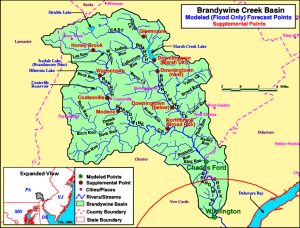While local towns had mixed report card in Clean Water Action study, all could do better, authors say
By Mike McGann, Editor, The Times

The 25 municipalities of the Brandywine Creek basin were graded this week for how their ordinances manage storm water runoff, with Pocopson ranking first and Valley and South Coatesville rated worst.
PENNSBURY — Two local municipalities scored worst — Valley and South Coatesville — in a report card issued Thursday by Clean Water Action (CWA), evaluating how zoning ordinances impacted storm water runoff and sediment collection in the Brandywine Creek.
The City of Coatesville scored above average, as did West Caln and Caln — among the 25 communities measured for how their zoning ordinances handle storm water run off. Pocopson and East Bradford had the best scores in the report, while Valley and South Coatesville were ranked well below average.
As local municipalities are being called on to reduce sediment runoff into local creeks — highlighted again as the Brandwine overran its banks again Thursday, flooding parts of Route 926 in Birmingham — CWA officials said their criteria we no-cost options for municipalities to reduce runoff and potentially help with compliance with tougher new state Department of Environmental Protection standards.
Most local communities fared fairly well in the survey, which ranked municipalities on a 1-100 scale. West Caln topped the local list, scoring 68 — just three points less than best scores, while Coatesville was scored at 64, Caln 62 — all above the average score of 60. Rated as below average were West Brandywine at 59, Sadsbury at 57, Modena at 51, and Valley and South Coatesville at 42.
None, though, earned CWA’s “Good” rating which would have required 80 points.
“Every town has room for improvement,” Joe Nye, CWA’s East Pennsylvania Program Organizer, noting that even the best of the local communities fell 29 points short of a perfect score and that, by CWA standards, 23 of the communities fell into the “inadequate” category. CWA rated any scores below 70 as “inadequate.”
According to Nye many of the issues involve paved areas — small changes to the amount and size of parking spaces required for various types of construction, he said, could have a big impact on whether rainwater soaks into the ground or runs into the Brandywine or one of its local feeder streams.
As virtually all communities in southern and central Chester County are facing new requirements in terms of municipal separate storm sewer systems (MS4), a few revisions to local zoning could go a long way.
“With MS4, municipalities need to update their ordinances to be more runoff-friendly,” Nye said, noting the requirement in the MS4 permit application process that asks municipalities to demonstrate zoning changes to improve stormwater runoff management.
But, he added, not every suggestion from CWA will work in every community, the goal, he said, is to suggestion no or little cost options to reduce runoff and help municipalities comply with MS4 requirements.
“It’s going to be a little different for each community,” Nye said.
One of the keys, Nye said, for what he termed “low-impact development” was to look for ways to reduce the total amount of non-permeable pavement. Of the 22 criteria CWA used for the report, many center on parking, sidewalks and road withs.
Many of the changes Nye and CWA suggest are fairly small, such as allowing for some smaller parking spaces for compact cars, canting sidewalks to drain into yards rather than onto roadways.
Nye also cautioned that the recommendations are for development moving forward, not to seek revision of existing streets, sidewalks and other developments.
“We’re not asking municipalities to tear up part of a road for this,” he said.
But as Wesley Horner, Senior Adviser for Water Resources for the Brandywine Conservancy noted, Thursday’s flooding — which came after a night of strong, but not unusual rainstorms — highlighted the fact that not taking action has a toll on the region.
“I think we’re all being haunted by all of this non-point source runoff,” Horner said. “It means we’re going to have to be constantly scrutinizing our ordinances.”
He added that the Brandywine Conservancy stands ready to work with municipalities to assist them in reworking ordinances and meeting their MS4 requirements.






